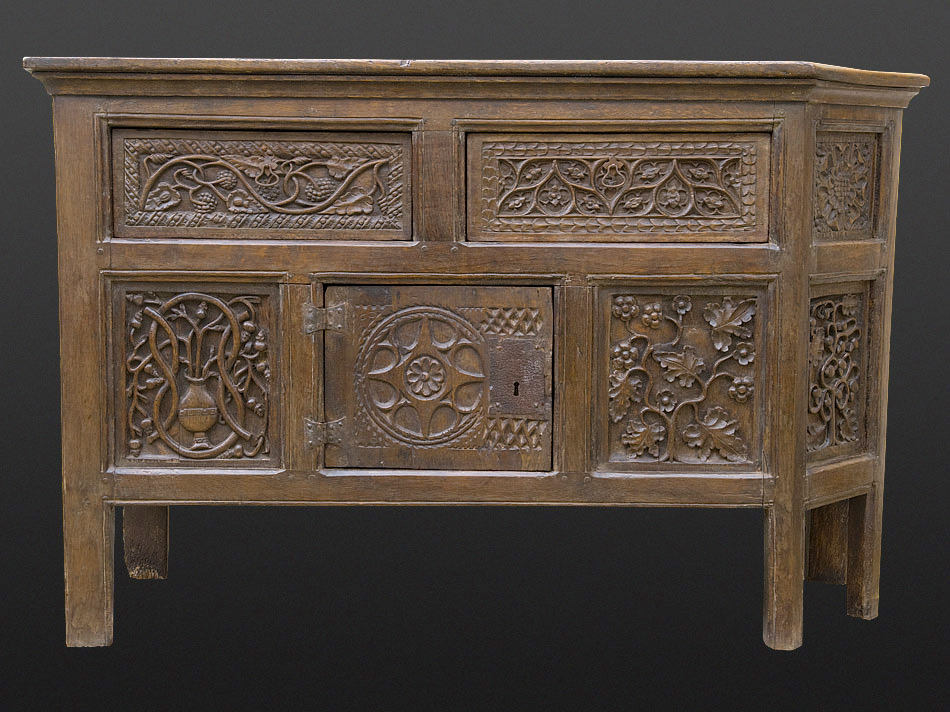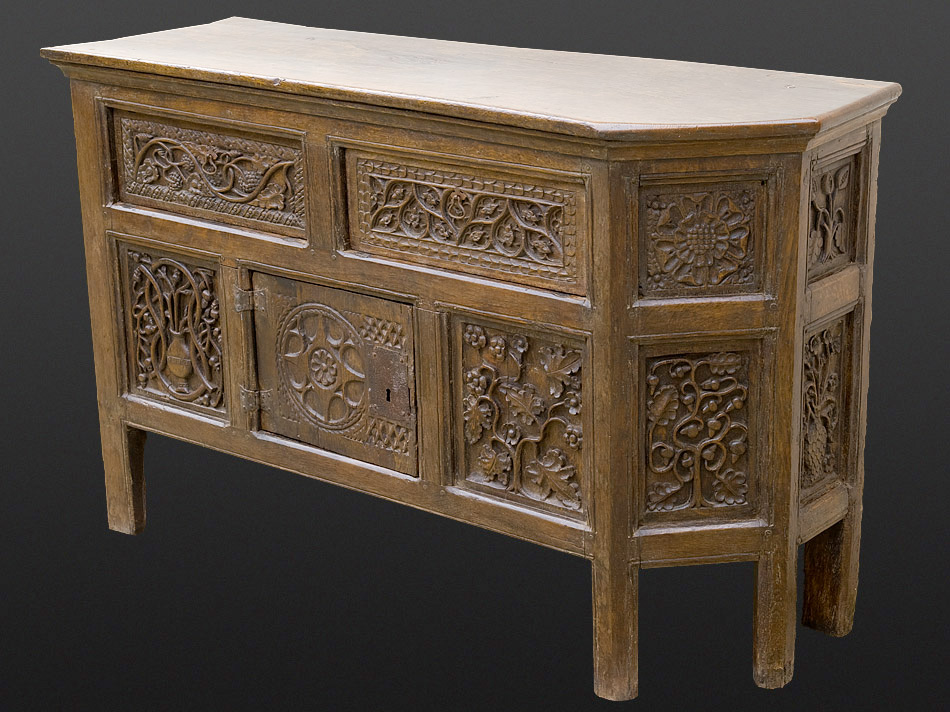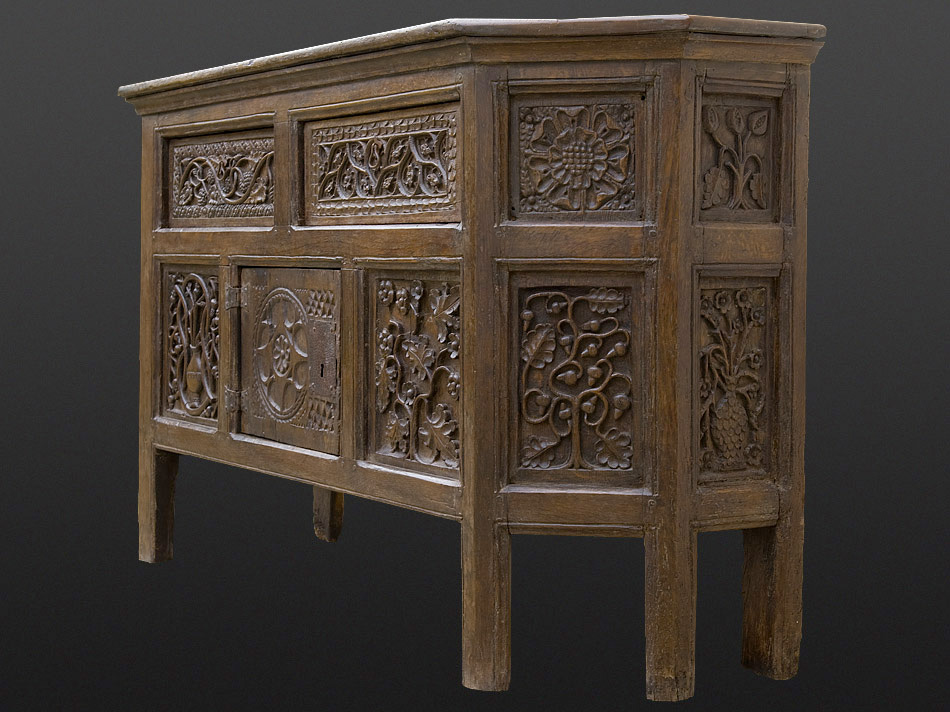Henry VIII carved oak canted cupboard
1509-1533
England, probably East Anglia
W 59" × H 39" × D 19"
Stock # MARH0220
SOLD
Henrican enclosed, joined buffet with doors and drawers carved with tracery and three-dimensionally modeled foliage, including representations of pomegranates and the Tudor Rose that directly reference the marriage of Henry VIII and Katherine of Aragon (1509-1533). Although pre-1550 English carving of this depth and intricacy is well represented by fixed woodwork, particularly in ecclesiastical contexts, the appearance of work of this level upon examples of movable furniture, in any condition, is an extreme rarity. Four other objects, all fragmentary, exhibit carving related in the conception and execution of motifs and the depth and intensity with which they were rendered. All date to within the same approximate timeframe and may constitute the work of a single network of possibly East Anglian joiners. Two restored remnants of joined tables with enclosed cupboards in the collection of the Victoria & Albert Museum (49-1919 and W.47-1910) bear panels carved with similar renderings of multi-petal flower-heads. On the unpublished example, this Tudor Rose panel is flanked by a panel carved with a representation of three pomegranates sprouting from a central trunk on entwined branches above downward facing asymmetric leaves.
A nearly identical panel is framed into the upper, canted side of the buffet. A second, less complete buffet, little more than an assemblage of surviving panels, juxtaposes a Tudor Rose panel of the same style with a more extensive set of tracery panels. The final object, a chest in a Paris institutional collection, is constructed with board sides and a joined facade that frames four panels carved with elaborate compositions of entwined branches linked to acorns, flower-heads, seedpod-like clusters, and frilled leaves closely related to the motifs on the buffet. The buffet, chest, and both joined tables display strongly French-derived design traits: flush-mounted panels on the un-canted side of one buffet, fine dovetails securing the sides of the chest, and masons mitred joints on all five objects. Indicative of the work of immigrant artisans, the Continentalized features of the buffet and its cognates correspond with the origin of a closely aligned body of fixed woodwork on the facade of the house built around 1510 for Thomas Paycock in Coggeshall, Essex. Paycock, the most prominent clothier in the principle textile-exporting community in East Anglia, most likely employed immigrant joiners who had arrived as part of the network of cross-Channel exchange facilitated by the sixteenth-century woolens trade. The headers, columns, and frieze-boards still in situ at his house are carved in a manner that directly parallels the work on the five surviving examples of furniture.
Intact, the structure of this object would have encompassed an additional tier in the form a second, enclosed cupboard, probably with a central, fixed panel. This missing section would likely have resembled what remains of the second known joined buffet of this type. Unlike the less complete upper section, this buffet is configured with only one canted side. The compelling possibility exists that this buffet, like the two buffets listed in the inventory of the Hampton Court bedchamber of Henry VIII, was one of a pair designed to flank a doorway or central dais.
Despite losses and alterations, the buffets ambitious structure, the caliber of carved ornament, and its secure, iconographic link to context firmly establish it as a significant monument of high-level sixteenth-century English joinery produced before the onset of theological change. Related examples of movable furniture of this scale and complexity simply do not exist, even in institutional settings.
Significant traces of probably original polychrome survive in the dropped-field surrounding the carving. Upper tier and central door lost; stiles reduced; drawers rebuilt; and some panels later cut, hinged, and refixed.
* One of the joined tables with cupboard in the collection of the Victoria & Albert Museum is illustrated as cat. 319 in English Medieval Furniture and Woodwork by Charles Tracey
* The surviving upper tier of the second known buffet is illustrated as figs 1-1k in The English Smile; English Furniture and The Renaissance , 1490-1590
* The chest in a Paris institution is illustrated as fig. 30 in Le Mobilier Francais Du Moyen Age a la Renaissance by Jacquieline Boccador
* The house of Thomas Paycocke appears as fig. 232 in Early English Furniture and Woodwork by Cescinsky and Gribble
* Simon Thurley, The Royal Palaces of Tudor England (New Haven and London: Yale University Press, 1993), p. 242.



